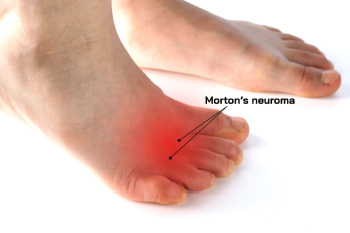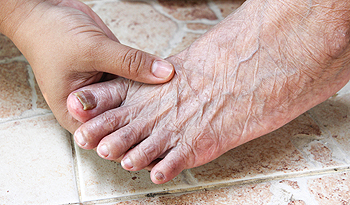Connect With Us
Blog
Items filtered by date: November 2024
Understanding Morton’s Neuroma

Morton’s neuroma is a painful condition involving the thickening of tissue around a nerve leading to the toes, most commonly affecting the area between the third and fourth toes. It often feels like standing on a pebble or experiencing a burning, tingling pain in the ball of the foot. Causes include repetitive stress or compression, commonly from wearing tight or high-heeled shoes. High-impact activities, flat feet, and bunions also increase the risk of developing Morton’s neuroma. Diagnosis typically involves a physical exam, imaging, and recreating symptoms through pressure on the affected area. Treatments range from footwear modifications, orthotics, and anti-inflammatory medications to more invasive options like corticosteroid injections or, in severe cases, surgery. The outlook is generally positive with proper management, and prevention focuses on wearing supportive, well-fitted shoes and avoiding prolonged foot stress. If you have symptoms of Morton’s neuroma, it is suggested that you visit a podiatrist who can provide a tailored treatment plan for relief.
Morton’s neuroma is a very uncomfortable condition to live with. If you think you have Morton’s neuroma, contact Scott Amoss, DPM of Advanced Foot & Ankle Specialists. our doctor will attend to all of your foot care needs and answer any of your related questions.
Morton’s Neuroma
Morton's neuroma is a painful foot condition that commonly affects the areas between the second and third or third and fourth toe, although other areas of the foot are also susceptible. Morton’s neuroma is caused by an inflamed nerve in the foot that is being squeezed and aggravated by surrounding bones.
What Increases the Chances of Having Morton’s Neuroma?
- Ill-fitting high heels or shoes that add pressure to the toe or foot
- Jogging, running or any sport that involves constant impact to the foot
- Flat feet, bunions, and any other foot deformities
Morton’s neuroma is a very treatable condition. Orthotics and shoe inserts can often be used to alleviate the pain on the forefront of the feet. In more severe cases, corticosteroids can also be prescribed. In order to figure out the best treatment for your neuroma, it’s recommended to seek the care of a podiatrist who can diagnose your condition and provide different treatment options.
If you have any questions, please feel free to contact our offices located in Whiting and Toms River, NJ . We offer the newest diagnostic and treatment technologies for all your foot care needs.
Causes and Symptoms of Ankle Sprains

Ankle sprains are fairly common injuries caused by overstretching or tearing of the ligaments that stabilize the ankle joint. They often result from a sudden twist or roll of the ankle, typically during sports, running on uneven ground, or even daily activities. People with previous ankle sprains, weak ankle ligaments, or wearing improper footwear are more prone to this injury. Symptoms include swelling, bruising, pain, and tenderness surrounding the ankle, especially when bearing weight, in addition to a reduced range of motion or joint instability. Immediate treatment usually involves rest and elevation to control swelling and pain. If you have injured your ankle, it is suggested that you visit a podiatrist who can provide an accurate diagnosis and appropriate treatment.
Ankle sprains are common but need immediate attention. If you need your feet checked, contact Scott Amoss, DPM from Advanced Foot & Ankle Specialists. our doctor can provide the care you need to keep you pain-free and on your feet.
How Does an Ankle Sprain Occur?
Ankle sprains take place when the ligaments in your ankle are torn or stretched beyond their limits. There are multiple ways that the ankle can become injured, including twisting or rolling over onto your ankle, putting undue stress on it, or causing trauma to the ankle itself.
What Are the Symptoms?
- Mild to moderate bruising
- Limited mobility
- Swelling
- Discoloration of the skin (depending on severity)
Preventing a Sprain
- Wearing appropriate shoes for the occasion
- Stretching before exercises and sports
- Knowing your limits
Treatment of a Sprain
Treatment of a sprain depends on the severity. Many times, people are told to rest and remain off their feet completely, while others are given an air cast. If the sprain is very severe, surgery may be required.
If you have suffered an ankle sprain previously, you may want to consider additional support such as a brace and regular exercises to strengthen the ankle.
If you have any questions please feel free to contact our offices located in Whiting and Toms River, NJ . We offer the newest diagnostic tools and technology to treat your foot and ankle needs.
Fungal Toenail Treatment Options

Fungal nails, or onychomycosis, is a common condition where a fungus infects the toenails, leading to discoloration, thickening, and brittleness. The primary causes include exposure to warm, moist environments, such as public showers or swimming pools, and underlying conditions like diabetes or weakened immune systems. Symptoms often start with a yellow or white spot under the nail, progressing to discoloration and potential separation from the nail bed. In some cases, the affected nail may become painful or develop a foul odor. A podiatrist can effectively diagnose and treat fungal toenails through various methods. Treatments may include topical antifungal medications, oral medications, and advanced options like laser therapy, which targets the infection without harming surrounding tissue. Laser treatments are gaining popularity for their effectiveness and minimal side effects. If you have toenail fungus, it is suggested that you schedule an appointment with a podiatrist for personalized care and treatment options.
If left untreated, toenail fungus may spread to other toenails, skin, or even fingernails. If you suspect you have toenail fungus it is important to seek treatment right away. For more information about treatment, contact Scott Amoss, DPM of Advanced Foot & Ankle Specialists. our doctor can provide the care you need to keep you pain-free and on your feet.
Symptoms
- Warped or oddly shaped nails
- Yellowish nails
- Loose/separated nail
- Buildup of bits and pieces of nail fragments under the nail
- Brittle, broken, thickened nail
Treatment
If self-care strategies and over-the-counter medications does not help your fungus, your podiatrist may give you a prescription drug instead. Even if you find relief from your toenail fungus symptoms, you may experience a repeat infection in the future.
Prevention
In order to prevent getting toenail fungus in the future, you should always make sure to wash your feet with soap and water. After washing, it is important to dry your feet thoroughly especially in between the toes. When trimming your toenails, be sure to trim straight across instead of in a rounded shape. It is crucial not to cover up discolored nails with nail polish because that will prevent your nail from being able to “breathe”.
In some cases, surgical procedure may be needed to remove the toenail fungus. Consult with your podiatrist about the best treatment options for your case of toenail fungus.
If you have any questions please contact our offices located in Whiting and Toms River, NJ . We offer the newest diagnostic and treatment technologies for all your foot and ankle needs.
Diabetic Neuropathy Is a Serious Complication

Diabetes can lead to several serious foot complications, with neuropathy being one of the most common and concerning. Diabetic neuropathy occurs when high blood sugar levels damage the nerves in the feet, leading to symptoms like numbness, tingling, or burning sensations. As nerve damage progresses, individuals may lose the ability to feel pain or temperature changes, which means injuries such as cuts, blisters, or sores may go unnoticed. This loss of sensation increases the risk of infections and ulcers, which can develop into more severe conditions if not treated promptly. Regular foot care and monitoring are essential for people with diabetes, as neuropathy can lead to serious complications, including amputations. If you have diabetes, it is strongly suggested that you visit a podiatrist for regular check-ups. The role of this foot doctor is imperative in preventing and managing diabetic foot issues.
Diabetic foot care is important in preventing foot ailments such as ulcers. If you are suffering from diabetes or have any other concerns about your feet, contact Scott Amoss, DPM from Advanced Foot & Ankle Specialists. our doctor can provide the care you need to keep you pain-free and on your feet.
Diabetic Foot Care
Diabetes affects millions of people every year. The condition can damage blood vessels in many parts of the body, especially the feet. Because of this, taking care of your feet is essential if you have diabetes, and having a podiatrist help monitor your foot health is highly recommended.
The Importance of Caring for Your Feet
- Routinely inspect your feet for bruises or sores.
- Wear socks that fit your feet comfortably.
- Wear comfortable shoes that provide adequate support.
Patients with diabetes should have their doctor monitor their blood levels, as blood sugar levels play such a huge role in diabetic care. Monitoring these levels on a regular basis is highly advised.
It is always best to inform your healthcare professional of any concerns you may have regarding your feet, especially for diabetic patients. Early treatment and routine foot examinations are keys to maintaining proper health, especially because severe complications can arise if proper treatment is not applied.
If you have any questions, please feel free to contact our offices located in Whiting and Toms River, NJ . We offer the newest diagnostic and treatment technologies for all your foot care needs.
